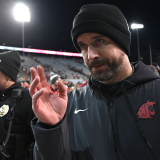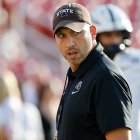
Maryland admitting fault is a start, but college athletes must take control of their well-being
We are past the time of there being little to no separation between coaching and player welfare

This is the time for college athletes to organize. Yeah, like a union with the ability to strike and all that. Forget all the noise about getting paid past cost of attendance or the name, image and likeness debate.
Your lives are at stake, boys and girls. The death of a Maryland football player is the most recent, sad reminder.
Someone has to be in charge. The well-heeled adults running a lot of these colleges and athletic departments simply are not.
You saw proof again Tuesday at a Maryland press conference where the president and athletic director threw themselves on a pyre of blame.
School president Wallace D. Loh said his school took "legal and moral responsibility" for the death of Jordan McNair. Good start at Maryland, but the end of player mistreatment nationwide isn't in sight.
It's time to consider -- maybe demand -- a union to oversee proper medical care and treatment for college athletes. For starters, perhaps a group that makes sure elementary medical protocol is followed. At Maryland, apparently it was not.
We know that now. McNair died on June 13 of heatstroke, according to his family, two weeks after he collapsed at a team workout. Maryland laid out a scenario Tuesday suggesting entry-level medical school procedures that could have saved McNair's life simply weren't performed.
We're talking about taking the player's temperature. It reportedly spiked at 106 before McNair was hospitalized. We're talking about a cold immersion bath to treat the effects of heatstroke.
"They basically misdiagnosed the situation," Loh said. "No vital signs were taken."
We're talking about making the obvious 911 call immediately when McNair showed distress. Instead, it took an hour, according to reports. That hour that could have decided McNair's life.
That passage of time paled in comparison to the 62 days it took for Maryland officials to accept the blame. On Tuesday, Loh said "some of our policies and protocols do not conform to best practices."
Why? For starters, best practices aren't laws or edicts or commandments. They're elaborate suggestions that make good ethical and professional sense.
They're also ignored far too often.
Talk to college training and medical professionals across the country, and they agree: There is a lack of independent care in college athletics. Too many of those training and medical types feel beholden to the coach.
There needs to be a reporting wall between the coaching staff and health care. We can only assume the majority of training/medical staffs report to the athletic director, not the coach.
If not, there is an inherent conflict of interest. The coach wants to win games. The medical professionals want to treat the injured.
Maryland will eventually find out if its standards were proper, as its investigation concludes in mid-September. It seems willing to scratch a multi-million dollar wrongful death settlement check to make sure that part of the nightmare goes away.
Meanwhile, another investigative committee has been created to determine whether the culture of Maryland football is indeed harmful to its players.
DJ Durkin, the coach and CEO of the football enterprise, remains employed while on indefinite administrative leave. His level of culpability -- if any -- supposedly will be revealed. It's possible that he and strength & conditioning coach Rick Court, whom the program split with on Tuesday, created a culture that intimidated the training staff into holding up an obviously distressed McNair back on May 29.
"Drag his ass across the field," ESPN quoted Maryland's longtime head football trainer as saying. This at a time when a teammate told ESPN that McNair "was not in control of his body."
It's also possible -- probable, perhaps – that the medical/training staff wasn't skilled enough to know the basics. Tuesday's press conference seemed to draw a line between the coaching staff and health care professionals.
But at Maryland, no amount of extra water breaks and added cooling stations even starts to address a culture that included "alleged bullying, alleged intimidation, alleged denigration of student-athletes," as Loh stated.
The school proved Tuesday it was in the mood to take full responsibility for McNair, but it refused to take on enough debt to fire Durkin at this juncture. Doing that might incur two multi-million dollar lawsuits -- one from the family, another from the coach -- that an athletic department ranked 12th in Big Ten revenue cannot handle.
The only job casualty on Tuesday was Court.
The question, then, is not whether we should trust Maryland to do the right thing ever again. Should we trust college athletics going forward?
There is a long, tragic history to consider:
A Google search of Devaughn Darling (Florida State), Ereck Plancher (UCF) or Aaron O'Neal (Missouri) brings up three cases of football players dying following alleged overexertion during practice. Each school either lost lawsuits resulting from the deaths or paid to settle them.
That's a snapshot from 2001-08. With the death of McNair, the first question after how he died is a basic one: How many more have to?
If you can't trust the school, coaches and/or medical staff -- all of whom should be committed to player safety -- who can you trust?
A union is an obvious safety net. There is a reason NFL players have collectively bargained an average of less than one fully added practice during the regular season. Or why players are paid for putting their bodies on the line at offseason organized team activities (OTAs).
It's because they can. They are the game, the labor force. Amateur college athletes have none of that leverage. It shows.
There's a reason why ESPN used a lot of anonymous sources in its story. Those players were afraid of retribution and/or the loss of their scholarships. And yeah, those anonymous sources were good enough for Maryland to put Durkin and several staffers on leave, basically fire their strength coach and open an investigation.
Again, this isn't about pay for play. That's a different discussion. This about "separation between coaching and health care," as one person close to the Maryland situation put it.
As in, make sure there is one.
Too many lives are at stake to trust the current model ever again.


















